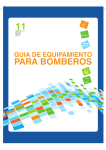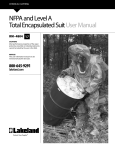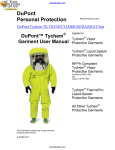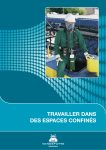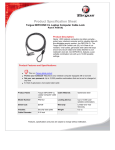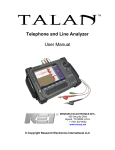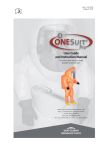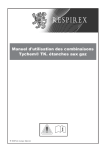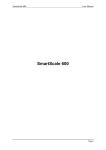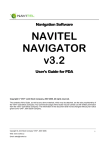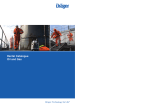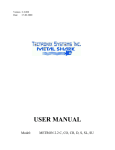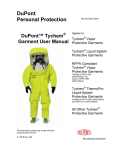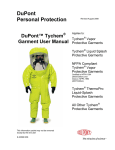Download the Interceptor User Manual
Transcript
BS EN 943-1: 2002 Total Encapsulated Type 1 Gas Tight Chemical suit User Instructions Caution:Most performance properties of a Gas-Tight suit or its individual elements cannot be tested by the user in the field Note: This User Information manual is to be removed from the garment only by the user This manual is in English. Local language instructions can be supplied separately Please contact [email protected] if you require a language other than English Table of Contents CE performance levels and label marking instructions Warnings and Warranty information Safety Considerations Warranty Card (copy, complete and return to Lakeland) BS EN 943: 2002 requirements & issues Safety & Health Program Requirements Maintenance & Repairs / Inspection frequency & details Pressure Test Kits assembly components & Instructions for pressure testing procedure Glove Replacement Guide Recommended Training and proper use Recommended undergarments and visor agents Further safety considerations Doffing, storage & Shelf life Decontamination guide Chemical Resistance Guide Aluminized over-cover specifications Lakeland Interceptor Specifications Component methods of attachment Size Charts (including glove and boot sizes) Further Warnings & Limitations Inspection Log Inspection check list Test Kit Part Numbers list Manufacturer Contact Information Page 1 Page 2 Page 3 Page 4 Page 5 Page 5 Page 6 Page 7 Page 8 Page 9 Page 9 Page 10 Page 10 Page 11 Page 11 Page 12 Page 13 Page 13 Page 14 Page 15 Page 16 Page 17 Page 18 Page 19 Note:Information following this sign includes an important warning and needs particular attention. Serious injury or death could result from not following such instructions!!! Information following this sign includes helpful hints, tips or procedures to help you avoid problems or save time 1. CE Performance Levels and Label marking instructions For Sizing information see Size Chart on Page 13 IMPORTANT WARNING!!! The Interceptor EN 943-1 gas-tight vapour protective suit is designed and sold as a single use garment. It is not intended to be used repeatedly. However, we understand that some users may choose to store the garment for future use or re-use it if it remains uncontaminated and undamaged after use. In this case such re-use is entirely at the user’s discretion and it is entirely the user’s responsibility to ensure the suit remains in a suitable condition; it should be thoroughly checked, inspected and pressure tested on first receipt (note the 3 month warranty), before any use and after every use before re-storing to confirm leak-tightness. Do not use the suit in any hazardous situation if it appears damaged, abraded, scratched or otherwise worn in any way or fails to achieve a positive pressure test result. In addition, we do not recommend a repeat use if the suit has been contaminated with a chemical as any contamination may adversely affect the fabric’s ability to resist permeation of any particular chemical WITHOUT THE EFFECT NECESSARILY BEING APPARENT THROUGH A NORMAL VISUAL INSPECTION. 1 Warning:- Warranty:- There are applications and chemicals for which Lakeland suits are not appropriate. This suit will perform as designed only if it is used and serviced according to the instructions. It is the sole responsibility of the user to select a suit and accessories such as chemically resistant boots, gloves, and other PPE not provided by Lakeland, which is appropriate for the intended use and which meets all appropriate EEC and local health and safety regulations. The following is made in lieu of all warranties expressed or implied including without limitation implied warranties or merchantability or fitness for a particular purpose:- Lakeland does not warrant that this suit meets the requirements of any safety code of any state, municipality or other jurisdiction other than the EEC standard BS EN943-1:2002 and BS EN943-2:2002. Seller shall not be liable for injury, loss or damage, direct or consequential, arising out of the use or inability to use the product. Before using, user shall be solely responsible for determining the suitability of the product for its intended use and user assumes all risk and liability whatsoever in connection therewith. Lakeland’s only warranty is that for a period of 90 days after the delivery of a Lakeland suit that the suit is free from defects in materials and workmanship when used in accordance with the instructions contained in this manual and subject to a user pressure test being conducted on receipt of the garment. The purchaser and all suit users must promptly notify Lakeland of any claim, whether based on contract, negligence, strict liability, or otherwise. This manual gives a general description of Lakeland’s EN 943-1&2:2002 Type 1 Gas-Tight complete suit. While some uses and performance capabilities are described, under no circumstances should the product be used except by qualified, trained personnel in accordance with OSHA training and other EEC and NIOSH regulations, and not until the instructions, labels, or other literature accompanying this product have been carefully read and understood and the precautions set forth therein followed. Only they contain the complete and detailed information concerning this product. Any person who reads this manual and is still uncertain about how to safely operate or service this suit should contact Lakeland Industries European sales office or local regional sales office for more information. See list of regional contact numbers below and at the back of this manual All Lakeland chemical and BS EN 943-1&2:2002 ensembles are manufactured and sold by Lakeland’s Chemical Clothing Divisions, a wholly owned division of Lakeland Industries, Inc The seller’s only obligation shall be to replace such products proved to be defective because of workmanship. This warranty does not extend to raw materials and components supplied to Lakeland or any of its subsidiaries or divisions. Safety and permeation data for Lakeland protective clothing is available upon request. As in almost all instances, we do not know and cannot contact end users of our products. It is therefore, incumbent upon safety distributors to distribute to the end users both Lakeland’s and the fabric manufacturer’s safety and permeation data and other safety and use information as updated. Such data does not attempt to address all of the safety issues associated with improper selection of a garment for the foreseeable application, use without adequate training, disregard of any warnings and instructions supplied by us or the fabric manufacturer and failure to maintain and inspect the garments. Users should discontinue using garments immediately if they become torn or abraded to avoid potential exposure to hazardous chemicals. Lakeland protective garments such as Interceptor are intended to be used only in conjunction with an organized safety protection program, the requirements of all regulations promulgated by relevant EEC or other standards or regulations. The foregoing may not be changed except by an agreement signed by an officer of the seller. In all events, we make no warranty of any kind whatsoever, express or implied, and all implied warranties of merchantability and fitness for a particular purpose are hereby disclaimed by us and excluded from any contract. For more information visit us at www. lakeland.com LIST OF REGIONAL CONTACT NUMBERS AND E-MAIL ADDRESSES Lakeland Europe (UK) Tel: +44 1430 478140 Lakeland USA Tel: 808-645-9291 Lakeland Asia-Pacific Tel: 08610 6437 9226 (Europe, Africa and Middle East) E: [email protected] E: [email protected] (Asia-Pacific – Australasia) E: [email protected] Lakeland Latin America (South & Central America) Tel: 00 562 551 8562: E: [email protected] Lakeland Canada Tel: 519 757 0700 E: [email protected] Lakeland India Tel: 0119 112 030 42261 E: [email protected] Lakeland Russia Tel: 08495 7757 264 E: [email protected] Lakeland Brazil Tel: 00 562 551 8562 E: [email protected] 2 Safety Considerations:Be sure to read and follow the information in this manual and all applicable EEC and local occupation safety and health regulations. Serious injury or death may occur from improper use of this garment. Proper use must be consistent with EN 943-1&2:2002 and any other relevant standards or regulations Continued... Powered air-purifying respirators (PAPR) cannot be worn with totally encapsulating, vapour protective Type 1 gas tight suits CE certified Lakeland chemical protective ensembles must where required incorporate a separate overcover to provide required abrasion resistance, puncture resistance, and/or protection from direct flame impingement This garment is not suitable for use in all situations and environments with all chemical and hazardous materials. All decisions regarding the choice of chemical protective clothing and its use must be made by trained and qualified safety professionals. It is the user’s responsibility to determine the level of exposure and the proper personal protective equipment (PPE) needed. Most performance properties cannot be tested by the users in the field. Refer to the Lakeland Permeation Guide or contact [email protected] for information regarding chemicals specific to your application Separate, user-supplied protective footwear specified in the Technical Data Package of this document. CE certified Lakeland chemical protective garments may include attached socks made of garment material. These socks must be worn inside the protective footwear. These socks are not suitable as outer footwear. CE certified Lakeland chemical protective garments are equipped with outer boot covers to prevent liquid pooling inside the boot. After the garment is donned, the boots are donned and the outer cover is pulled down over the upper portion of the boot. The cuffs of Lakeland chemical protective garments that do not have socks should be worn over the upper portion of the user’s boot to prevent run-off and pooling of liquid within the boot. Adhesive taping of the garment cuff to the boot does not provide a leak-proof seal. Taping should only be used to hold the garment cuff in position over the boot. If a leak-proof seal is required, then garments with sock and boot covers should be selected. If any of the following symptoms develop during use of any Lakeland chemical protective garment, immediately leave the contaminated area, undergo field decontamination (if exposed), and doff the garment: - Fever / Difficulty breathing / Nausea / Excessive Tiredness / Dizziness / Numbness / Any unusual odour or taste / Eye or skin irritation / Narrowing, dimming or blurring of vision / Claustrophobia / Loss of balance or any other physical or mental condition that may indicate any problem CE certified Lakeland chemical protective garments may or may not be supplied with attached chemical protective gloves. If not attached, user-supplied chemical protective gloves should be worn with the sleeve of the garment over the gauntlet of the glove. Adhesive taping of the glove to sleeve interface does not provide a leak-proof seal. Taping should only be used to hold the sleeve in position over the glove gauntlet. If a leak-proof seal between the glove and sleeve is required, then a garment with attached gloves should be selected. A suit with double cuffs with overflap can also be supplied Wearer Qualifications:This garment should be worn only by persons who are properly trained in the usage of this garment and who are in good physical condition to perform tasks whilst wearing it. Consult a physician before donning a suit to ensure you are capable of wearing this garment under the expected work conditions and environment. Additional Equipment:- Some Lakeland chemical protective garments utilize multiple chemical-resistant gloves to achieve the chemical barrier and physical performance requirements. Removal of one of the glove layers may compromise chemical barrier or glove durability. To help protect the wearer and to perform as intended this chemical protective garment must be worn with several additional items of personal protective equipment (PPE). At a minimum the following components must be worn in addition to this suit:- Separate, user-supplied, full-face respiratory protection such as: 1) an open circuit, self-contained breathing apparatus (SCBA) which is also certified as compliant with relevant EEC standards Standard on Open-Circuit Self-Contained Breathing Apparatus for Fire Service, 2) An external breathing air supply (air line system with pass-through and escape bottle) where appropriate, or 3) A closed-circuit, self-contained breathing apparatus (re-breather). Chemical gloves if attached are not designed for mechanical protection against cuts so separate, cutresistant outer gloves may be appropriate where required It is the user’s responsibility to verify that the glove and the glove/sleeve interface will provide adequate barrier and physical performance for the intended task. User-supplied head protection. The use of footwear with toe crush protection, cutresistant, and slip-resistant soles is recommended Hearing protection may be required due to high levels of external noise or high noise levels generated by supplied air systems. WARNING:Before use you MUST read all “Warranty Information” and “Warnings and Limitations” contained in this manual. A warranty registration card is included in this Warranty manual after Card this section. Please complete this and return to your regional Lakeland office and keep a copy for your records. - Other protective equipment may be warranted based on the situation to deal with additional hazards which may include, but are not limited to: Flammable or explosive Environments / Decontamination / Extreme heat (heat exhaustion) or cold (Hypothermia) / Asphyxiating atmosphere / Other physical hazards (sharp points / rough surfaces / falling debris etc) / Slipping or falling / Visibility or Communications 3 Warranty and Registration Form Please copy, complete and return to your region Lakeland office. 4 EN 943 Type 1&2 Requirements Safety & Health Program Type 1 represents the greatest danger of respiratory, eye or skin damage from hazardous vapours, gases, particulates, sudden splash, immersion or contact with hazardous materials. It calls for total encapsulation in a gas-tight chemical suit with self contained breathing apparatus (SCBA) and appropriate accessories. Type 1 / 2 Conditions may include: Unknown Hazards immediately Dangerous to Life Health (IDLH) Atmospheres Atmospheres containing less than 19.5% oxygen Percutaneous Chemicals Vapours / Liquids Injurious to Skin An effective and comprehensive safety and health program is essential in reducing work-related injuries and illnesses and in maintaining a safe and healthy work environment. Use of such garments as Interceptor requires each employer to develop and implement a written safety and health program that identifies, evaluates, and controls safety and health hazards and provides emergency response procedures for each hazardous waste site or treatment, storage, and disposal facility. The program must be periodically updated and made available to all affected employees, contractors and subcontractors. The employer also should inform contractors and subcontractors and employees of any identifiable health hazards or potential fire or explosion hazards before they enter the worksite. This written program must include specific and detailed information on the following topics: Personal Protective Equipment Required:1. Self Contained Breathing Apparatus (SCBA), or positive pressure supplied air respirator with SCBA (NIOSH approved) 1. An organizational work plan. 2. Fully encapsulating chemical resistant suit 3. A site-specific program. 3. Suitable Coveralls* 4. Information and training program. 4. Long underwear* 5. Personal protective equipment program. 5. Gloves-(outer), chemical resistant Gloves-(inner) 6. Monitoring. 6. Boots-chemical resistant, steel toe and shank 7. Medical surveillance program. 7. Hard hat* (under suit) 8. Decontamination procedures. 8. Disposable protective suit, gloves, and boots* 9. Emergency response program. 9. Two-way radio communication* (intrinsically safe) 10. An air leakage test to ensure suit is vapour proof. 2. Site evaluation, control and hazard assessment. Cleaning and Marking the suit *Optional Additional Protective Properties In addition to meeting all EN 943 requirements, Lakeland imposes even higher levels of protection on Interceptor:For example:- The EN 943 standard requires permeation testing on fabric, fabric seams and closures. Lakeland have also conducted permeation testing on the fabric / visor seam to confirm this seam also meets the required levels of protection - Seams are required to be sealed in order to achieve a permeation barrier on seams as well as fabric. This could be achieved by a single sealing tape on the outside of the seam. However Lakeland also apply sealing tape on the INSIDE as well as the OUTSIDE of the seam for double sealing - EN 943 requires a minimum seam strength of 300N. Intereptor seam strength is tested to 648N – more than double the required strength - EN 943 requires that joints between components require a minimum tensile strength of 100N. The joint between the Interceptor sleeve and Butyl glove is tested in excess of 200N – more than double the requirement - Comfort is a factor of safety. Lakeland Interceptor fabric has been developed to maximize chemical barrier but also maximise comfort. The fabric is 15% lighter than comparable products and this can contribute to increased comfort, higher work rates and greater efficiency NOTE: Cleaning procedures are not an acceptable procedure for decontamination. The user should develop and implement a decontamination procedure for each of the chemicals to which the suit has been exposed. After decontamination, wash down the suit with a solution of a low suds detergent and water. A product like Tide® would be acceptable. Use warm to moderately hot water to cleanse suit inside and out. Wash off solution according to EEC, state, and/or local pollution regulations. This may mean using a catch basin, such as a wading pool. Hang until dry at room temperature. Warning: Do not use garments that are not thoroughly cleaned and dried Marking Recommendations and Restrictions:If required, for example to denote a suit as for training use only, marking can be made on either your Interceptor suit using a black laundry marker or marker pen. 5 Maintenance & Repairs – Pressure Testing Frequency and Details of Inspection Upon receipt, the gas tight suit should be tested to insure that no damage has occurred during shipment. Following initial testing the suit should be tested before and after every use and at least annually, whether it is used or not. If the suit fails the test, see “Testing” and “Returns” for more information. In addition to testing, the suit must be inspected after every use and at least annually. An Inspection Checklist has been provided at the back of this manual to assist in the inspection. For outline instruction on conducting a pressure test see page 7. Inspection Record When replacing exhaust valve diaphragms after testing or inspection, care must be taken to insure that the diaphragm locking stem is secured properly into the positioning groove on the stem. If the diaphragm locking stem is pulled too far into the valve housing (beyond the positioning groove) the diaphragm may not seat properly. Visual inspection from both outside and inside the garment is recommended to assure proper seating of the diaphragm. 6. The date that the person making the inspection signedoff, indicating that the suit is ready for reuse. See “Annual and other Inspections Log”. (Page 15) Check the zipper for overall condition, worn or damaged teeth, and ease of operation Lubricate zipper lightly with paraffin, which is readily available in most grocery stores. Paraffin should be applied lightly to the inner and outer elements. After cycling the zipper several times, the excess flakes should be removed. Do not use a sticky lubricant which could gather and hold particles of dirt, grease, or contaminant. 2. Check valve diaphragm installation closely to be sure that the positioning groove on the diaphragm locking stem is properly positioned into the valve housing. Repairs The gloves on the suit can be replaced by the end user while in the field. See “Glove Replacements” for instructions. Any other modifications or repairs must be done only by Lakeland personnel Warning: all modifications and repairs should be undertaken by qualified Lakeland personnel Returns:DO NOT SEND A CONTAMINATED SUIT TO LAKELAND. SUITS MUST BE DECONTAMINATED, CLEANED AND DRIED BEFORE RETURN OR THEY WILL BE RETURNED TO THE SENDER WITHOUT ANY INSPECTION When returning a suit to Lakeland please follow the procedure below:Attach the following to the side of the return shipping container: If the suit has not been used, a letter which states that the suit is in a new and unused condition. If the suit has been used, a copy of the decontamination document, listing the procedures used, and a statement indicating that the suit contains no detectable residual contamination. 1. A Return Goods Authorization number must be on each container returned. This number will be given out to you by Lakeland’s Customer Service Department. 2. The Suit should be shipped folded in a case or box. The suit should not be pressurized during shipment Before using the suit, look at the inspection record and check: 1. The date that the suit was last decontaminated. 2. The level of decontamination obtained. 3. The date when the suit was cleaned and sanitized. 4. The date that the suit was pressure tested. 5. That the suit is checked and pressure tested at least annually Physical Inspection 1. Look at the suit closely, checking for missing or damaged parts. 3. Look for holes and tears in the fabric. 4. Look for wear or abrasion that could allow a chemical to penetrate the suit. Inspect all seams thoroughly. 5. Check the gloves and boots for tears or abrasions. Pull on the sock ends and gloves to make sure that they are firmly attached. 6. Check the lens for cracks or deep scratches. 7. Check that the zipper has been lubricated; see section entitled “”Maintenance & Repairs” Inspect the breathing apparatus according to the manufacturer’s instructions. Check the pressure gauge to be sure that the cylinder is fully charged. If you find any signs of wear, any damaged or missing parts or any other indication of suit degradation do not use the suit!!! Retirement & Disposal Criteria Use department procedures for disposal of suit. Lakeland gas tight suits can be incinerated. In disposable suitable consideration should be given to any possible contamination of the suit. Refer to the manufacturer’s instructions that come with the test kit for proper procedures to perform a pressure test Lakeland Test Kits 00200 Universal Test Kit 00010 Basic Test Kit* For more information about test kits contact [email protected] 6 Test Kit Component Assembly and Instructions for Pressure Testing Twist lock with male adapter, hose assembly and brass tee. Twist lock goes into the exhaust valve at the head. Brass tee connects to your air source. This connection is used to inflate the suit. Use only regulated air! Do not use more than 125 psi to connect to test unit! Twist lock with female adapter, hose assembly and gauge. Twist lock goes into the exhaust valve at the left. This connection connects to the pressure gauge to measure the pressure inside the suit We recommend using ONLY Lakeland test kits available from your local regional Lakeland office. Pressure Test Instructions A summary of the basic instructions for conducting a Manufacturers Pressure Test For more detailed instructions contact saleseurope@lakeland or see the video on the Interceptor page at www.lakeland.com/europe Note that the Type 1 certification process requires a test according to EN464. However this test inflates the suit to a pressure of 1750 Pa or 7” water column. The EN 464 test is designed to test a suit “to destruction” – not necessary for periodical maintenance pressure testing. For maintenance testing we recommend NOT inflating the suit beyond 1250 Pa (5” water column) to avoid risking damage to the suit. 1) The suit should be laid face down on a smooth, clean surface. Use the Interceptor storage back or some other soft material underneath the visor to prevent damage or scratching of the lens 2) Ensure all folds and creases are removed. 3) With the suit fully unzipped remove the diaphragms from the exhaust valves. This is done by gently pinching the diaphragm from the outside and pulling the diaphragm locator pin from the inside with the other hand, gently removing the diaphragm from the valve. 4) Attach the valve connector from the air source to the valve housing at the back of the hood. Do not use an air supply greater than 125psi!!! Valve connectors are available from Lakeland or as part of the Lakeland pressure test kits 5) Attach the valve connector which connects to the pressure gauge to the valve at the back of the suit 6) Connect the air hoses to the air supply and pressure gauge. 7) Fully close the interceptor zip, ensuring the zip passes the zip tab at the top 8) Open the air supply and gently inflate the suite to the required pressure (see below for EN 464 requirements) 9) Maintain pressure for the required conditioning period 10) Start a stop clock to time the required test period 11) Note and record the pressure at the beginning and end of the test period on the Test and Inspection Card in this manual The basic requirements for the Inteceptor Manufacturers Pressure Test are:1) Initially inflate the suit to a pressure of 1250 Pa (12.5 mbar / 5 inH20 2) Maintain the suit pressure at 1250 Pa for a short period. This should incorporate ensuring all creases and folds are removed from the suit and may require adding further air. 3) After this initiation period reduce the pressure by releasing air to 1000 Pa (4” Water Column / 10mbar) 4) Start the test. The test should last for 4 minutes. 5) Performance Requirements : Do not touch or move the suit during the test period as this may affect the results. During the 4minute test period the pressure in the suite should not drop to any lower than 800 Pa (3.2” water column / 8mbar). If the pressure has dropped to a pressure lower than this the suit has failed and should not be used. 7 Glove Replacement Guides Warning: If gloves are replaced by user a pressure test must be immediately performed to ensure seal is correct and airtight Instructions for Ring and Clamp Assembly Removal Removal 1. Remove outer glove assembly by unlocking the Quick Disconnect System. 2. Remove tape over clamp at the top of glove. 3. Using a hex driver, loosen screw on glove clamp; and remove clamp. Do not use a screwdriver to loosen clamp, as screwdriver may slip and damage suit. Remove outer gloves. 1. Turn sleeve inside out. 2. Remove tape and rubber band over clamp at top of glove. 3. Using a hex socket or ratchet, loosen screw on glove clamp, remove clamp. Do not use a screwdriver to loosen clamp, as screwdriver may slip and damage suit. 4. Remove rubber band. Ring and Clamp Assembly Installation 1. Sleeve should be inside out 2. Insert PVC ring in glove so that 2 inches of the glove is above top of ring 5. Pull glove assembly out of sleeve. 3. Place glove in sleeve, fingers toward you and middle finger in line with shoulder seam. Pull until tight. Instructions for Quick disconnect assembly removal 4. Place elastic band centred on line with PVC ring. 1. Remove outer glove assembly by unlocking the Quick Disconnect System. 2. Remove tape over clamp at the top of glove. 5. Centre glove clamp on rubber band, using a hex socket driver or ratchet to tighten screw. Tighten clamp. Do not use a screwdriver to tighten screw, as screwdriver may slip and damage suit. 3. Using a hex driver, loosen screw on glove clamp; and remove clamp. Do not use a screwdriver to loosen clamp , as screwdriver may slip and damage suit. Remove outer gloves 6. Turn the 2” glove overlap over clamp. Place wide rubber band over clamp. Instructions for Quick disconnect assembly Installation 8. Turn suit sleeve right side out. 7. Securely wrap area over PVC ring and clamp with flexible tape. 1. Sleeve should be inside out. 2. Insert Silvershield® glove through male glove ring, turn at least 3 inches of the glove edge back over the edge of the glove ring. 3. Insert the male glove ring through the suit opening down to the sleeve opening. 4. Place the clamp 3/8” from the edge of the glove ring, and tighten firmly in place using a hex driver The locking pin must be centred with the middle finger of the glove and the sleeve seam to insure proper alignment 5. Place a 7/8” rubber band over the clamp to prevent it from puncturing the suit, cover the rubber band with at least 3 rounds of black electrical tape 6. Pull sleeve back through suit and straighten 7. Insert female glove ring (grooved side first) into outer glove so that the glove extends 3” past the grove in the ring. Place 5/8” rubber band over cuff clamp into the grove in the ring and tighten using a hex driver. Do not use a screwdriver, as screwdriver may slip and damage suit. 8. Cover the clamp with at least three rounds of black electrical tape to prevent clamp from damaging the suit 9. Place a 5/8” wide rubber band between glove and clamp to prevent damage to glove. Place clamp in centre of groove on top of rubber band. Female notch in glove ring must be aligned with the thumb of the outer glove, this will allow the two glove system to align correctly and discourage loosen of the assembly due to movement in the wrist area. 8 Recommended Training and Proper Use Recommended Undergarments and visor agents Employers are required to develop and implement a program to inform workers (including contractors and subcontractors) performing hazardous waste operations of the level and degree of exposure they are likely to encounter Wear cotton underwear and socks to help absorb perspiration. Coveralls made from flame resistant synthetic materials, such as Fyrban® or Tecasafe®, offered by Lakeland Industries, are recommended, especially if exposure to flash-fire is a concern. Coveralls should have sleeves that can be closed tightly and legs that can be tucked into the socks. If the gas tight suit is to be worn in a cold environment, wear thermal underwear to help stay warm. Under extreme conditions, the lens may fog up. Carry a clean cloth with you to wipe the lens from the inside. Anti-fog agents can be purchased from most local stores. Lakeland Industries does not sell or apply any agents to the suit lens Employers are also required to develop and implement procedures for introducing effective new technologies that provide improved worker protection in hazardous waste operations. Examples include foams, absorbents, neutralizers, etc Training makes workers aware of the potential hazards they may encounter and provides the necessary knowledge and skills to perform their work with minimal risk to their safety and health. The employer must develop a training program for all employees exposed to safety and health hazards when working with hazardous chemicals or working in hazardous waste operations. Both supervisors and workers must be trained to recognize and prevent hazards; to select, care for; and use respirators properly as well as other types of personal protective equipment; to understand engineering controls and their use; to understand and conduct proper decontamination procedures; to understand the emergency response plan, medical surveillance requirements, confined space entry procedures, spill containment program, and any other appropriate or required work practices. Workers must also know the names of relevant personnel and their alternates responsible for site safety and health. Employees at all sites must not perform any work in or around hazardous waste operations or sites unless they have been trained to the level required by their job function and responsibility and have been certified by their instructor as having the necessary training. All emergency responders must receive refresher training sufficient to maintain or demonstrate competency annually. Employee training requirements are further defined by the nature of the work (e.g., temporary emergency response personnel, fire-fighters, safety officers, Hazmat personnel, incident commanders, etc.) These requirements are likely to include recognizing and knowing the hazardous materials and their risks, knowing how to select and use appropriate personal protective equipment, and knowing the appropriate control, containment, or confinement procedures and how to implement them. It is your responsibility, as a user of this Gas Tight Total encapsulated Suit, to be aware of and comply with all phases of your employer’s safety and health program, including training and with all relevant EEC, state or local health and safety regulations or standards. Failure to do so could lead to an accident which may result in severe personal injury or death For zipper lubrication see “Maintenance & Repairs for more information Good safety practices require an assistant to help you don and doff the suit. This is easier and quicker, and you will avoid stumbling or tripping which may result in personal injury or damage to the suit. Follow these general guidelines in putting on the suit: 1. Make sure the suit has been visually inspected, air pressure tested and is free from defects. Also make sure the correct suit has been selected for the intended use. 2. Underclothing should be worn under the chemical suit. As a minimum, a long sleeve shirt and long pants or “long underwear” are recommended. 3. Remove all personal affects which might result in damage to the suit (e.g. pens, badges, jewellery, etc.). 4. Remove shoes. Most boots don’t allow street shoes. Lakeland’s approved boots do not. 5. Tuck pant cuff into socks to make donning of suit legs and sock boot easier. 6. If using an SCBA check the level of air, complete all connections, make all adjustments in accordance with the manufacturer’s procedures. Do not put the SCBA face piece on until the suit is ready to be zipped up tightly, unless required by its design. 7. While seated place both legs into the suit. Stand up and attach the internal waist belt. Belt is intended to help adjust the fit of the suit. 8. Turn on the air supply, put on the SCBA face-piece and make sure air supply system is working properly. 9. Place arms and head inside the suit, close the zipper, then Velcro shut the fly over the top of the zipper. 10. The person assisting should check to make certain the zipper is completely closed past the zip tab at the top of the zip and that the zip flaps are completely closed and secured, all airline connections are tight, and that the suit appears to be working properly. For more detailed donning instructions please read the donning instructions sheet supplied with the suit separately. 9 Further Safety Considerations Like any piece of complex equipment, this gas-tight suit will perform as designed only if used and serviced according to these supplied instructions. All individuals who have or will have the responsibility for using the suit must read these precautions carefully and understand them. Failure to do so may result in severe personal injury or death. 1. Avoid direct flame contact. Do not use the gas-tight suit near a fire or open flame. The material will melt. 2. Do not wear a suit without breathable air. This is a gas-tight suit and an air supply is mandatory to prevent suffocation. An air-line alone is prohibited by OSHA regulations in IDLH atmospheres. 3. Do not use an oxygen cylinder or oxygen generating breathing apparatus while wearing a gas-tight suit. A severe fire hazard could result. 4. Never work alone in hazardous areas. Always work with another person and have at least one person on standby with equal protective equipment. 5. Do not pull on an air supply hose as a retrieval device. To do so may cause the air-supply hose to tear out of the suit and expose the wearer. 6. Avoid continuous exposure. Do not expose the suit to a constant liquid splash or deluge, or wade through liquid pools on purpose. 7. Prevent heat stress. Workers who wear total encapsulating suits must be in good physical condition. Consult a medical doctor before donning a gas-tight suit to be sure you are capable of wearing it under expected use conditions. The wearer can take several steps which may prevent heat stress, such as wearing an ice or cooling vest (available from Lakeland), feeding the suit with body-cooling air, and taking frequent rest periods during the work session. Leave the hazardous area immediately if you experience any of these or any other unusual or unexpected symptoms; fever, nausea, dizziness, eye irritation, difficulty in breathing, becoming fatigued or any unusual odour or taste. 8. Doffing Procedure The person assisting in the doffing procedure should be wearing the appropriate attire selected by Qualified Safety Personnel. The suit may be contaminated with the chemical so suitable PPE such as a Lakeland ChemMAX® chemical protective coverall should be used along with suitable gloves, face protection and any other required PPE. 1. The person assisting should open the zipper flaps by separating the Velcro attached to the fly and open the zipper by pulling the zipper tab at the opening of the zipper 2. The user should pull their arms back into the body of the suit, remove their hard hat, and hand hat to the assistant (this will prevent the assistant from touching the inner suit with their gloves that may be wet or contaminated. 3. Carefully remove the head and arms from the suit 4. Loosen the air supply mask (allow the mask to hang around the neck until the air supply has been cut off. Remove the air system per the instructions provided with that particular system 5. Loosen the suit belt and allow suit to fall. Assume a sitting position for stability. The assistant should remove the outer boots and hold the bottom of each leg to allow the user to remove legs from the suit more easily. Storage, Shelf life & Decontamination Recommended Storage Practices 1. Before storage ensure full, suitable decontamination and cleaning has been conducted 2. Store the Complete Ensemble in a clean, dry location, away from direct sunlight. 3. Suit should be stored laid flat, if possible. 4. Store the suit with zipper completely open. 5. At least annually perform inspection with checklist at the back of this manual, and perform the suit pressure test using according to the instructions 6. EN 943 complete ensembles are to be stored the same as any other chemical suit. 7. Suits can be stored in their original carry-bags, or on a hanger. Be careful not to fold or crease the visor if returning into the original bag for storage Shelf Life Chemical suits contain components made from various polymer or rubber materials for which there is no specific life data currently available. Based on the physical condition of the suit, it is recommended that downgrading the suit to “Training Use Only” be considered after five years. If this is done; each suit will need to be visually marked on the outer side “For Training Use Only”, so that all personnel will be aware that it has been downgraded. 10 Decontamination – Chemical Chemical Resistance Guide “a decontamination procedure shall be developed, communicated to employees and implemented before any employees or equipment may enter areas on site where potential for exposure to hazardous substances exists”. A protective garment must resist hazardous chemical attack from three different routes of entry: Permeation, Penetration and Degradation. Permeation describes a process by which chemicals migrate through a material. It involves chemical solubility in a material and the ability for chemicals to “diffuse” through the material as a liquid, gas, or vapour. Measuring permeation is important because chemicals may penetrate protective materials without visible effects. Many of today’s chemicals are toxic in vapour form, through skin absorption or inhalation. The chemical suit material resists permeation of these chemical vapours, depending on the type of challenge chemical. EN 369, EN 374 or EN 6529 provide EC approved methods for assessing permeation rates through fabrics and tests are required for approval to EN 943. A full list of chemicals tested is available. Test results to US test F739 are also available. Decontamination is a complex operation that requires a detailed plan of procedures. Actual decontamination procedures must be developed by those with full information on the type and level of the contaminant. Consult the Materials Safety Data Sheet (MSDS) for information on the hazrads presented by any substances that you are working with. After decontamination, suits may be hand washed using warm water and a mild detergent (see “Cleaning Instructions” in this manual). Appropriate PPE should be worn during these activities to prevent contact with any residual contamination. After washing, suits should be rinsed well with warm water and hung away from intense heat or sunlight to dry. Before reuse, a qualified health professional must determine that an adequate level of decontamination has been achieved Chemical suits which become contaminated with toxic chemicals or show signs of physical wear or damage, (see “Maintenance And Repairs”), should be retired or disposed of in a safe and suitable manner. Decontamination in the case of Chemical contamination At the scene, place contaminated garments inside a leakproof container and marked as “Biological Contaminated.” These garments must be destroyed by a Certified Waste Disposal Company. DO NOT attempt to decontaminate any garments that have come in contact with any Biological Threat. Penetration occurs when a chemical enters the suit through a physical imperfection, such as a damaged seam or zipper, a tear, a pinhole, a loose glove, boot, or lens. Suits must be leak-tested in the field to ensure their penetration resistance. Simple bubble-indicating leak tests, without measuring pressure-drop over time, are not practical. The Lakeland Test Kit (part number 00010) measures penetration resistance by indicating pressure-drop over time. It permits the user to inflate the suit with an SCBA or other air source, measure the pressure put into the suit, and the rate at which the pressure may drop. Degradation takes place when a chemical degrades one or more of the suit’s physical properties, such as material thickness, colour, tear resistance, abrasion resistance, and so forth. Such a physical change may not necessarily affect the material’s permeation resistance. However just the opposite is also possible. A challenge chemical could permeate the garment material almost immediately without changing its physical appearance at all. All Test results provided by Lakeland have been conducted under laboratory conditions-not actual workplace conditions. They address breakthrough characteristics and do not account for other performance characteristics. They are not, in and of themselves, recommendations. Lakeland chemical suits are designed to be worn over regular work clothing, and are not designed to protect from all hazards in the work place. Additional equipment such as protective eyewear, protective boots, additional gloves, hard hats, cooling systems, communications systems, etc. may be required and should be selected by a safety professional. Lakeland Industries, Inc. cannot guarantee that any Level A suits is applicable to your particular situation, or assume responsibility for use thereof, because of such unknown variables as nature of work, type of exposure, concentration of exposure, etc. Style Identification INT 640 : Fully Encapsulated front entry gas tight suit Expanded back / attached sock boots with flaps / 2 layer standard width face shield / 2 exhaust valves INT 650 : Fully Encapsulated rear entry gas tight suit Expanded back / attached sock boots with flaps / 2 layer standard width face shield / 2 exhaust valves INT 640W : Fully Encapsulated front entry gas tight suit Expanded back / attached sock boots with flaps / 2 layer wide vision face shield / 2 exhaust valves INT 650W : Fully Encapsulated rear entry gas tight suit Expanded back / attached sock boots with flaps / 2 layer wide vision face shield / 2 exhaust valves See separate documentation for full specifications 11 Aluminized Over-Covers Specifications and Component Descriptions for Aluminized over-covers An aluminized over-cover may be used in areas where protection from the risk of flash fire or intense heat may be required. Lakeland over-covers feature the following specifications:1. Garment Materials-are Aluminized Glass. 2. Suit design is to be worn only in conjunction with an approved gas-tight Chemical suit that accommodates a self contained breathing apparatus inside the suit. 3. All seams are stitched with Nomex® thread on the inside. 4. Closure is a 4” wide flap made out of the suit material; held in place with 1” black full-length Velcro. Front Entry: starts at left side of hood front and across body. Rear Entry: centre back. 5. Visor/Lens is 10 mil FEP Teflon® stitched in with Nomex® thread on the inside of the suit. 6. The head area is designed to accommodate a SCBA face piece and allow user to wear a hard cap or fireman’s helmet. 7. The optional pass-throughs; if purchased; will be located in the right area to allow for hook-up of outside air for breathing and cooling. 8. Three valve covers designed to fit over the top of the Level A Chemical Suit exhaust valve system, 1-located on the right side of the back of the hood, 1-located on the right side of the expanded back, 1-located on the left side of the expanded back. 9. Colour of the suit is silver. 10. The spacious sleeve is designed to fit in conjunction with the requirements of the Gas tight Chemical Suit. For sizing see “Chemical Suit Size Charts”. At present Interceptor Aluminized over suits, whilst anty Registration Card available, are not certified to any EN standard. Work is currently being undertaken to test the over-covers in a Thermal Mannequin testing procedure whilst the cover is worn over an Interceptor suit, the aim being to assess the damage or otherwise to the Interceptor suit beneath in the event of a flash over-fire. ALUMINIZED OVER-COVER 12 Lakeland Interceptor Specifications Methods of Component Attachment Specifications and component descriptions for Interceptor EN 943-1 2002 gas Tight Suits Garment material Single needle, sealed with seam tape on both sides 1. Interceptor fabric is a multi-layer laminated film. Visor material Single needle, triple sealed with seam tape and unique, patented visor etching Glove material Ring and clamp assembly or quick-disconnect assembly Footwear material 5. Visor/Lens materials- is a 40 mil PVC lens and a 10 mil FEP Teflon® lens sandwiched together using a specialized seam tape and process. This Visor/Lens is designed to ensure maximum visibility. Wide-vision versions available. Sock boot, single needle stitch, double sealed with boot overflap Garment closure Single needle stitch, triple sealed 6. Head area-is designed large enough to accommodate a SCBA face piece and to be able to allow user to wear a hard cap or fireman’s helmet Attached overcover Attached at valve cover with Velcro® (if applicable) 2. Suit Design - Expanded back to accommodate wearing of self contained breathing apparatus inside suit. 3. All seams stitched with 50/2 Permaspun® thread and sealed with specialized seam tape inside and out. 4. Zipper closure is a 48” PVC OEB design zipper with a vapour-proof closure by a 4” wide flap of suit material, and held in place by 5/8” full length Velcro. Front Entry: left side of hood and across back. Rear entry: centre back. 7. Two exhaust valves designed to maintain a positive pressure in the suit when a breathing apparatus is in use are located as follows: on the right side of the back of the hood and on the left side of the expanded back. 8. Gloves on Interceptor gas tight certified ensembles are as follows:Standard: 10mil Butyl outer glove with an inner North Silvershield® glove providing superior chemical protection. In this case an additional outer glove for cut protection may be required (not supplied). A separate pair of cotton liner gloves to be worn inside for comfort and to ease removal of hands from gloves inside the suit is also provided Optional: St Gobain “OneGlove®” triple layer system (additional cost) Chemical Suit Size Charts 9. The suit has attached sock boots with a boot over-flap to fit over suitable chemical boots (not supplied). Both sock boots and over-flap are constructed of Interceptor material. 10. Standard colour of the suit is Blue (grey and orange optional). 11. Spacious sleeve design allows wearer to have access to SCBA controls by pulling arm from sleeve while still in suit. The suit is designed to allow room for 2-way radio communication systems. 12. For sizes see “Chemical Suit Size Charts.” 13. Fabric and seams have achieved a minimum of >480 permeation time against the 16 chemicals defined in EN 943. For more information on chemical permeation tests and existing data, or to arrange testing of specific chemicals please contact [email protected] 14. Suit must pass a pressure test according to EN 464 before use. 15. Labelling inside the suit contains Serial Number and date of manufacture and factory pressure test. 16. Chest labelling features elements required for CE marking to EN 943-1 & 2 13 Recommended boot and glove size chart - Chemical suit size versus Glove and outer boot size Suit Size Extra Small - Medium Large Extra Large 2 Extra Large Boot Size UK Euro Glove Size 7–8 9-11 11-12 13-15 41-42 43-44 45-46 48-49 Large Large Extra large Extra large Lakeland Industries Inc. Total Encapsulated / Gas Tight suit height & size chart Body Height 6’0” /182cm Note: If you are wearing structural fire-fighting gear or other heavy or think clothing it may be advisable to move up one size, depending on the restrictions of your clothing. 5’10” /178cm 5’8” /173cm 5’6” /168cm This size chart accommodates the use of SCBA, hard hats, communication devices etc. 5’4” /162cm Height is shown in feet / inches and cm. Weight is shown in Lbs & Kilos. 5’2” /157cm 5’0” /152cm Weight Lbs 41 50 59 68 77 86 86 104 114 123 132 Kilos See donning for adjustment Procedures 14 Further Warnings and Limitations This ensemble is not suitable for use in all situations and environments with all chemical and hazardous materials. All decisions regarding the choice and usage of chemical protective clothing must be done by trained and qualified safety professionals. It is the user’s responsibility to determine the level of exposure and the proper personal protective equipment needed and to confirm that Interceptor is appropriate for the application in question. Lakeland chemical protective ensembles that are certified to EN943-1 may require an over-cover. The protective overcover provides additional protection against abrasion, cut, tear or puncture, and direct flame impingement. All components of the specified ensemble must be worn to be compliant with the requirements of any relevant standard. Lakeland chemical protective garments will burn (with the exception of Pyrolon®). These garments should not be worn around heat, open flames, sparks or any other possible ignition source nor in potentially explosive or flammable environments If the Lakeland chemical protective garment is abraded, cut, torn, punctured or otherwise and in any way breached, do not use. The chemical protective garment material has finite resistance to abrasion, cut, tear and puncture. If the Lakeland chemical protective garment is damaged during use, retreat immediately to a safe environment, thoroughly decontaminate the garment, then dispose of it in a safe manner. No single protective material will protect against all chemicals for all situations. If unsure, the best course of action is for a customer’s own laboratory to test the primary protective garment materials against the specific chemical hazard, at the temperature and in the concentrations to be encountered. Lakeland Industries, Inc. will provide free swatches of primary garment materials for testing and can provide you with a list of testing facilities are suggested simple test methods if required. In some cases, where appropriate and where possible, Lakeland will organise testing against specific chemicals for you. Please contact [email protected] Provide Hearing Protection If noise levels inside this ensemble exceed regulatory noise levels, hearing protection must be provided. Use hearing protection recommended by a safety professional which does not interfere with the operation or use of the garment. Communications A chemical protective garment hampers communication. The use of a personal communication system should be considered. Users should also consider establishing a system of clear and simple hand signals to communicate essential issues during training, work, and for emergency situations where respirators and chemical protective garments are worn Positive Pressure Excessive, internal positive pressure can damage a vapour-protective garment. Do not inflate vapour-protective garments above a pressure of 7 inches (18cm) water column Limitations of Use This ensemble is not intended for protection against radiological hazards. This ensemble is not intended for protection from cryogenic liquids and gases (colder than -200° C). If there is a risk of exposure to liquefied gases warmer than -100° C, the use of an ensemble certified to the relevant liquefied gas standards should be considered. Note: It may be essential to protect the wearer from thermal transfer-related physical harm, such as frostbite, by providing the wearer with insulating undergarments. Chemical Permeation Data Before using a protective ensemble in a chemical situation, consult the chemical permeation data appropriate to the garment material. Note that seams, visors and closures may have lower or different permeation times than the garments’ material. This information is to be used as a guide only. The permeation performance of any material depends on a number of factors including chemical concentration, temperature, time and amount of exposure. Due to the large number of variables, it is impossible for all ensemble materials to be tested against all chemicals, all combinations or mixtures, and all temperatures at which the chemical might be encountered. Chemical permeation tests are performed under laboratory conditions -- not actual workplace conditions. They address general chemical breakthrough characteristics and do not account for physical performance characteristics that affect a barrier such as abrasion, flex fatigue, puncture, tear, oxidative degradation, or degraded performance due to previous contamination. For further information on Interceptor Chemical permeation data or to request testing of Interceptor fabric against specific chemicals, or for information on any other Lakelandapparel for protection against chemicals, heat or flame, contact Lakeland at [email protected] Lakeland Industries is one of the world’s leading manufacturers of Industrial garments for protection against chemicals, heat and flames. A complete range of superior quality garments is offered, including lightweight garments for Type 5 & 6 applications, a comprehensive range of Type 3 and 4 chemical splash and spray protective garments, limited use and re-usable garments for protection against heat, flame, welding and similar processes and arc flash, aluminized garments for industrial heat protection, fire fighters clothing and a range of hand an arm garments for chemical and mechanical protection. For further information contact Lakeland at [email protected] 15 Annual and Other Inspections Log Lakeland gas tight suits should be inspected annually AS A MINIMUM including a full pressure test. Pressure tests and visual inspections before and after every use should also be conducted. Use this chart to record annual and other inspections. Inspections and Pressure Test Record Purchase Date.................................... Purchased From ....................................... Serial Number.................................... Style & Size............................................... Inspection date Inspected by Remarks Inspection / air test results Removed from service date...................................................................................... Person......................................................................................................................... Reason......................................................................................................................... ...................................................................................................................................... ...................................................................................................................................... 16 Gas Tight Suit Inspection Checklist Interceptor suits should be checked immediately on receipt and then before and after every use. The following should be assessed carefully. Material Check for any abrasions, holes or tears. Zipper Check for overall condition, worn or damaged teeth, ease of operation. Lubricate zipper lightly with paraffin, which is readily available in most grocery stores. Paraffin should be applied lightly to the inner and outer elements. After cycling the fastener several times, the excess flakes should be removed. Do not use s sticky lubricant, which could gather and hold particles of dirt, grease, or contaminant. Garment should be stored with the fastener open Visor Check there are no splits, cracks or deep scratches. Check the integrity of the join with the suit material Gloves Check for glove integrity, PVC ring where applicable, quality of rubber bands and tightness of metal ring Exhalation Valves Check for freedom from obstructions or dirt. If replacement valves are needed, send suit back to Lakeland for replacement Seams Visually check for split seams, tears or separations of material Leak Text Log Follow Procedure for Pressure Testing. Mark the Inspection log according to your findings. Date and sign so that the status of the suit will be known at all times. Shelf Life If the suit has been stored for five years we recommend it should be downgraded to “training use only”. It should be clearly marked as such so all potential users are aware it should only be used as a training suit 17 Test Kit Part Numbers Parts List Part No RM-5001 RM-5002 RM-5003 RM-5004 RM-5005 RM 5006 RM-5007 RM-5008 RM-5009 RM-5010 RM-5011 RM-5012 RM-5013 RM-5014 RM-5016 RM-5017 RM-5018 RM-5019 RM-5020 Description Brass quick Disconnect ¼” x ¼” Brass reducer (female) ¼” x ¼“ Brass cross ¼” FTP Brass nipple ¼” Brass bleed valve Brass max. Adhesive Quick connect ¼” body w/barb, white Quick connect with ¼” MPT, white nylon Quick connect with 1/8” MPT, white nylon ¼” x 1/8” Reducing Hex nipple M x M Brass ¼” pipe plug Test Kit case Test Kit Exhaust Valve plug Clear PVC tubing 3/16” Foam Insert Magnehelic guage A-369 guage stand bracket Rubber gaskets for plug (B.O.M.) Quick connect ¼” insert w/barb Part No RM-5021 RM-5022 RM-5023 RM-5024 RM-5027 RM-5028 RM-5029 RM-5030 RM-5031 RM-5032 RM-5033 RM-5034 RM-5035 RM-5036 RM-5049 RM5051 Description Quick connect ¼” with MPT Instruction sheet Supplementary instruction sheet Amulinimum dunp valve plug with 3/8” threaded hole ½ Lb pop-off valve ¼” x ¼” NPT hose connection 10Lb. pop-off vavle ¼” brass tee female thread npt. Alarm timer Shut-off valve Flat wire holder 7/8”” chair tip (dump valve plug) 3/8” brass street elbow 3/8” x 3/8” plug coupler npt male connection Dump valve plug with ¼” ipt Dump valve plug 18 Lakeland Key Contact Details and Numbers Sales Region Company Tel Address HEAD OFFICE Lakeland Industries Inc. Tel 0163 198 19700 Fax 0631 981 9751 [email protected] 701-7 Koehler Avenue, Ronkonkoma, NY 11779 USA USA Lakeland Industries Inc Chemical Protective Clothing Division Toll Free: 808-645-9291 Tel: 256-854-3565 Fax: 256-584-3565 202 pride lane SW Decatur, AL 35603 Canada Lakeland Protective Wear Tel: 519-757-0700 Fax: 519-757-0799 [email protected] 59 Bury Court Brantford, ON N3S 0A9 Canada Lakeland Europe Ltd Tel: +44 1430 478140 Fax: +44 1430 478144 [email protected] JetPark 2 244 Main Road Newport East Yorkshire HU15 2RP Europe, Africa & Middle East India Asia & Asia Pacific Brazil Latin America Russia Lakeland India Tel: 0119 112 030 42261Fax: 0119 112 025 62078 [email protected] 24 Noida Special Economic Zone, Noida Phase ||, District Gautam, Budh Nagar, UP201305, India Tel: 08610 6437 9226 Fax: 08610 643 79918 [email protected] Unit 412, Building C, Yeqing Plaza, No.9 Wangjing Bei Lu, Beijing 100102, China [email protected] Tel: 00541 1115 2940 583 Ruo do Luxemburgo, 260, Lotes 82/83 COndominio Industrial Presidente Vargas, Pijara, Salvador Bahia 41230-130 Lakeland Argentina Tel: 00562 551 8562 Fax: 00562 556 4357 Av. Roca 4250, Lote 110 Parque Industrial Florida Oeste, Vicente Lopez Buenos Aires, Argentina Lakeland Russia Tel: 084957757264 Fax: 089037926748 [email protected] Lakeland Asia Pacific Lakeland Brazil Russia, Moscow, 38km of MKAD, VL. STR. 1, Office #201, ZIP 117574 Interceptor®, ChemMAX® and Fyrban® are registered trademarks of Lakeland Industries Inc Silvershield® is a registered trademark of the North company Tide® is a registered trade mark of Procter & Gamble Tecasafe® is a registered trademark of Tencate BV March 02, 2011 Rev 1.0 ©2011 19





















